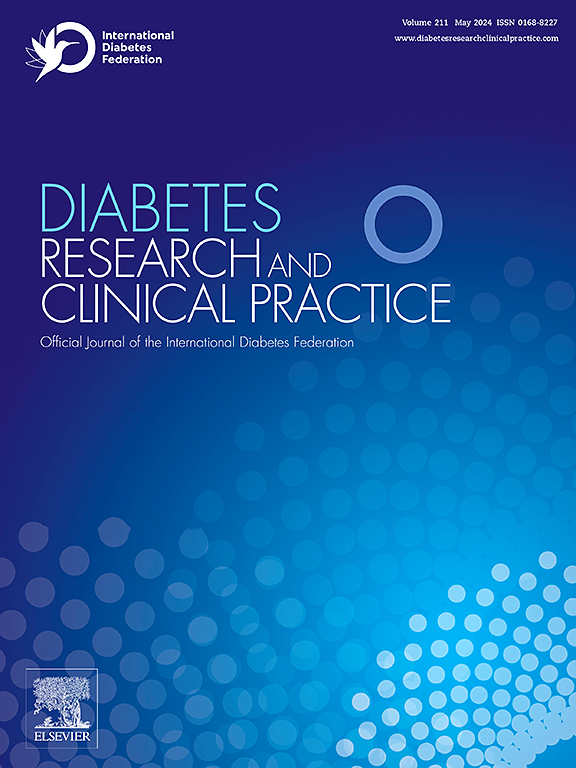作为补充预测指标的人体测量指数与 2 型糖尿病发病率之间的关系;松下队列研究 21。
IF 6.1
3区 医学
Q1 ENDOCRINOLOGY & METABOLISM
引用次数: 0
摘要
目的:比较体重指数(BMI)、腰围(WC)、腰围校正体重指数(wBMI)、体形指数(ABSI)和腰围身高比(WHtR)对 2 型糖尿病发病率的预测能力,并确定日本人口的实用临界值:本研究使用了 2008 年至 2021 年期间在松下公司进行体检的 155,623 名参与者的数据。结果:有8800人罹患2型糖尿病:结果:研究期间有 8800 人罹患 2 型糖尿病。男性 WHtR 的 ROC 曲线下面积较高(0.717,95 % 置信区间 [CI]:0.710-0.724),临界值为 0.497,而女性 wBMI(0.829,95 % CI:0.808-0.848)和 WHtR(0.826,95 % CI:0.806-0.845)的 ROC 曲线下面积较高,临界值分别为 18.6 kg/m 和 0.510。研究还表明,WHtR 对男性最有效,而在女性中,WHtR 和 wBMI 预测 2 型糖尿病的效果优于 WC,与 BMI 相当:结论:WHtR 在预测男性 2 型糖尿病方面表现出更高的有效性,而 WHtR 和 wBMI 在预测女性 2 型糖尿病方面的有效性均高于 WC,几乎与 BMI 相当。本文章由计算机程序翻译,如有差异,请以英文原文为准。
Associations between anthropometric indices as complementary predictors and incidence of type 2 diabetes; Panasonic Cohort Study 21
Aims
To compare the predictive abilities of body mass index (BMI), waist circumference (WC), waist-corrected BMI (wBMI), a body shape index (ABSI), and waist-to-height ratio (WHtR) for the incidence of type 2 diabetes and determine the practical cut-off values for the Japanese population.
Methods
This study used data from 155,623 participants who had medical checkups with Panasonic Corporation between 2008 and 2021. Predictive abilities of anthropometric indices were evaluated at 13 years using time-dependent receiver operating characteristic (ROC) curve analyses.
Results
8,800 developed type 2 diabetes during the study period. The area under the ROC curve for the WHtR was high (0.717, 95 % confidence interval [CI]: 0.710–0.724), with cut-off value of 0.497 in men, while those for wBMI (0.829, 95 % CI: 0.808–0.848) and WHtR (0.826, 95 % CI: 0.806–0.845) were high in women, with cut-off values of 18.6 kg/m and 0.510, respectively. It was also showed WHtR was the most effective in men, while WHtR and wBMI outperformed WC and were comparable to BMI in women for predicting type 2 diabetes.
Conclusions
WHtR demonstrated superior effectiveness in predicting type 2 diabetes in men, while both WHtR and wBMI showed higher effectiveness than WC and were almost equivalent to BMI in women.
求助全文
通过发布文献求助,成功后即可免费获取论文全文。
去求助
来源期刊

Diabetes research and clinical practice
医学-内分泌学与代谢
CiteScore
10.30
自引率
3.90%
发文量
862
审稿时长
32 days
期刊介绍:
Diabetes Research and Clinical Practice is an international journal for health-care providers and clinically oriented researchers that publishes high-quality original research articles and expert reviews in diabetes and related areas. The role of the journal is to provide a venue for dissemination of knowledge and discussion of topics related to diabetes clinical research and patient care. Topics of focus include translational science, genetics, immunology, nutrition, psychosocial research, epidemiology, prevention, socio-economic research, complications, new treatments, technologies and therapy.
 求助内容:
求助内容: 应助结果提醒方式:
应助结果提醒方式:


